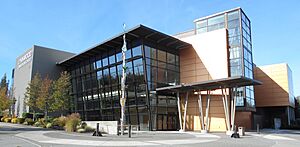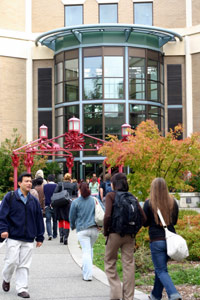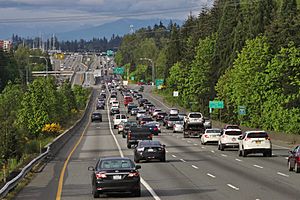Lynnwood, Washington facts for kids
Quick facts for kids
Lynnwood
|
||
|---|---|---|
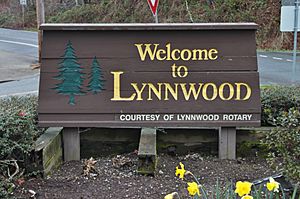 |
||
|
||
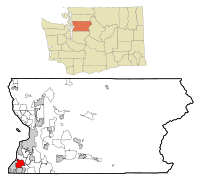
Location of Lynnwood in Snohomish County
|
||
| Country | United States | |
| State | Washington | |
| County | Snohomish | |
| Incorporated | April 23, 1959 | |
| Government | ||
| • Type | Mayor–council | |
| Area | ||
| • Total | 7.89 sq mi (20.44 km2) | |
| • Land | 7.88 sq mi (20.40 km2) | |
| • Water | 0.02 sq mi (0.04 km2) | |
| Elevation | 394 ft (120 m) | |
| Population
(2020)
|
||
| • Total | 38,568 | |
| • Estimate
(2023)
|
43,867 | |
| • Density | 5,143.49/sq mi (1,985.91/km2) | |
| Time zone | UTC-8 (PST) | |
| • Summer (DST) | UTC-7 (PDT) | |
| ZIP codes |
98026, 98036, 98037, 98046, 98087
|
|
| Area code | 425 | |
| FIPS code | 53-40840 | |
| GNIS feature ID | 1512414 | |
Lynnwood is a city in Snohomish County, Washington, United States. It is part of the larger Seattle metropolitan area. The city is about 16 miles (26 km) north of Seattle and 13 miles (21 km) south of Everett. It sits near where two major highways, Interstate 5 and Interstate 405, meet.
Lynnwood is the fourth-largest city in Snohomish County. In 2020, its population was 38,568 people. It's often seen as a suburb or a place where people live and commute to work elsewhere. However, Lynnwood also has many stores and growing businesses. The Alderwood Mall is a big shopping center there.
The city also has a community college, a convention center, and a large transit center for buses and trains. Several big companies, like Zumiez, have their main offices in Lynnwood.
The area where Lynnwood is now was first settled by farmers in the late 1800s and early 1900s. One of these settlements was called Alderwood Manor, which was a planned farming community. Lynnwood got its name from a realtor's wife. It started to grow in the late 1940s around the intersection of Highway 99 and 196th Street Southwest. The city officially became a city on April 23, 1959. It grew a lot after Interstates 5 and 405 were built. When Alderwood Mall opened in 1979, the eastern part of Lynnwood became a major shopping and business area.
Contents
History of Lynnwood
Early Days and Native Americans
Before American settlers arrived, the Snohomish tribe of Native Americans lived in the Lynnwood area during the summer. They would hunt, fish, gather berries, and grow roots there. In 1855, after signing a treaty, the Snohomish people moved to the Tulalip reservation. This opened the land for American settlers.
The first American settlers arrived in the 1880s. Duncan Hunter, a stonemason from Scotland, was one of the first. He claimed 80 acres of land in 1889. This land later became the city's Pioneer Park.
Alderwood Manor and Early Growth
In the early 1900s, logging companies cut down many trees in the Lynnwood area. In 1910, the Seattle–Everett Interurban Railway arrived, making travel easier. This also brought people who wanted to buy land.
In 1917, the Puget Mill Company created a planned community called "Alderwood Manor." They sold small plots of land to people who wanted to start farms. There was even a "demonstration farm" to teach new residents how to raise chickens and crops. By 1922, Alderwood Manor had over 1,463 people and many chickens.

How Lynnwood Got Its Name
In the 1930s, the new Pacific Highway opened. This shifted growth away from Alderwood Manor. In 1937, a realtor named Karl O'Brien bought land along Highway 99. He named his new development "Lynnwood" after his wife, Lynn. Other businesses nearby started using the name too. In 1946, the local business group officially chose "Lynnwood" as the name.
Becoming a City
Lynnwood got its first post office in 1948. In the early 1950s, the area grew slowly because it lacked services like sewers. Residents wanted to join Edmonds, a nearby city, but they were not allowed. So, they decided to form their own city.
In 1959, residents voted to make Lynnwood an official city. The vote passed easily. Jack Bennett was elected as the first mayor. Lynnwood officially became a city on April 23, 1959.
Modern Lynnwood Develops
In its first few years, Lynnwood started offering city services. It built a sewage treatment plant, a public park, and new streets. In 1969, the city began building its civic center, which included the city hall and public library. These buildings opened in 1971. Later, a police station and a recreation center were added.
The opening of Interstate 5 in 1965 changed Lynnwood's center of business. It moved east towards Alderwood Manor. In 1979, the Alderwood Mall opened. This led to a big boom in shopping and homes in Lynnwood during the 1980s. The Interstate 5 and Interstate 405 interchange was finished in 1984. This made it easier for people from other areas to reach Lynnwood.
During the 1980s, Lynnwood also gained its first office parks. These housed high-tech companies. Lynnwood became the largest shopping area in the county. In the late 1990s, the state rebuilt parts of Interstate 5 in Lynnwood. The city opened a convention center in 2005. This was part of a plan to create a "city center" with more businesses and homes. Construction on this city center began in 2015.
Geography of Lynnwood
Where is Lynnwood?
Lynnwood covers about 7.86 square miles (20.4 square kilometers). Most of this is land, with a small amount of water. The city is in the southwestern part of Snohomish County. It is part of the Seattle metropolitan area.
Lynnwood is located where Interstate 5 and Interstate 405 meet. It is about 16 miles (26 km) north of Seattle. It is also 19 miles (31 km) northwest of Bellevue and 13 miles (21 km) south of Everett.
Natural Features
Lynnwood sits on a plateau about 300 to 600 feet (91 to 183 meters) above Puget Sound. The city has hills and valleys. Many small streams and basins drain into Swamp Creek or Puget Sound. Scriber Lake and Hall Lake are also in Lynnwood. One of the highest points in the Seattle area, Lake Serene Hill, is 649 feet (198 m) tall and is near Lynnwood. From Lynnwood, you can see the Olympic Mountains to the west and the Cascade Mountains to the east.
Lynnwood's Main Areas
The main shopping and business area is often called the "Lynnwood Triangle." It is bordered by Interstate 5 to the east, 196th Street Southwest to the south, and 44th Avenue West to the west. This area is planned to become the city's main downtown, with a future light rail station and many new buildings.
Economy and Jobs
| Employer | Employees |
|---|---|
| 1. Edmonds School District | 2,965 |
| 2. City of Lynnwood | 513 |
| 3. Nordstrom | 490 |
| 4. Costco | 488 |
| 5. Macy's | 366 |
| 6. Fred Meyer | 306 |
| 7. J. C. Penney | 241 |
| 8. ADP | 211 |
| 9. Zumiez | 211 |
| 10. Target Corporation | 181 |
In 2015, about 19,095 Lynnwood residents were working or looking for jobs. Only about 12 percent of Lynnwood residents work within the city itself. Many people commute to larger cities like Seattle, Everett, or Bellevue for work. The average one-way commute for Lynnwood workers was about 30 minutes. Most people drive alone to work.
The biggest industries for Lynnwood residents are education and healthcare. Retail (stores) and food services are also very common.
Lynnwood is also a big job center for Snohomish County. In 2012, there were about 24,767 jobs in Lynnwood. The retail sector, especially around Alderwood Mall, employs 7,000 people. It also brings in half of the city's tax money. Large non-retail employers include the Edmonds School District and the city government. The clothing company Zumiez and knife maker SOG Specialty Knives have their main offices in Lynnwood.
Population of Lynnwood
| Historical population | |||
|---|---|---|---|
| Census | Pop. | %± | |
| 1960 | 7,207 | — | |
| 1970 | 16,919 | 134.8% | |
| 1980 | 22,641 | 33.8% | |
| 1990 | 28,695 | 26.7% | |
| 2000 | 33,847 | 18.0% | |
| 2010 | 35,836 | 5.9% | |
| 2020 | 38,568 | 7.6% | |
| 2023 (est.) | 43,867 | 22.4% | |
| U.S. Decennial Census | |||
In 1960, Lynnwood had 7,207 residents. By 1970, this number had grown to almost 17,000. From 1970 to 1990, the city's population nearly doubled. This growth was due to new areas joining the city and more people moving in. During this time, many Asian Americans, especially from Korea and Vietnam, moved to Lynnwood. By 2000, they made up 14 percent of the city's population.
In 2015, Lynnwood's population was estimated to be 36,420. By 2035, it is expected to grow to over 54,400 people within the city limits.
Education in Lynnwood
Public schools in Lynnwood are run by the Edmonds School District. This district also serves nearby cities like Edmonds and Mountlake Terrace. In 2014, the district had about 20,847 students. It has 41 schools, with 16 of them in or near Lynnwood.
Lynnwood has three high schools: Lynnwood High School, Meadowdale High School, and Scriber Lake High School. Lynnwood High School moved to a new campus in northern Bothell.
Lynnwood is also home to two colleges. Edmonds College, started in 1967, offers two-year degree programs. About 11,100 students attend each quarter. Central Washington University offers four-year degrees at its Lynnwood campus. It has shared space with Edmonds College since 1975.
There are also several private schools in Lynnwood, including The Soundview School and Brighton School.
Culture and Recreation
Parks and Fun Activities
Lynnwood has over 350 acres (140 ha) of open space in 19 parks. It also has 14 miles (23 km) of trails for walking and biking. Some of this open space is kept as natural areas, like Lund's Gulch and Scriber Creek.
The city has special places for fun, including a golf course, a skate park, sports fields, a water park, and a senior center. Central Lynnwood has two main parks: the Scriber Lake nature reserve and Wilcox Park, which was the city's first park. The city also hosts community events like the Fair on 44th block party and outdoor movie nights.
Media and Library
From 1958 to 2012, Lynnwood had a weekly newspaper called The Enterprise. Today, Lynnwood is served by Lynnwood Today, a local blog that started in 2010.
Lynnwood is part of the larger Seattle–Tacoma media market. This means it gets news and entertainment from Seattle-based TV stations and radio stations.
Lynnwood's public library opened on October 1, 1960. It is part of the Sno-Isle Libraries system. The library has moved and expanded several times to serve Lynnwood's growing population. It is the most visited library in the Sno-Isle system, with over 504,000 visits each year.
Historical Places
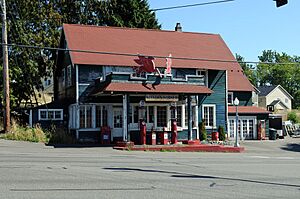
Lynnwood has one place listed on the National Register of Historic Places (NRHP). This is Keeler's Korner, an old gas station built in 1927 on Highway 99.
The Alderwood Manor Heritage Association was formed in 1991. This group works to save old buildings. They helped create the $1.8 million Heritage Park, which opened in 2004. This park has old buildings from the early 1900s, like the Wickers Building and a cottage. It also has a restored old trolley car.
Two other buildings in Lynnwood might also be added to the NRHP: the Masonic Temple (built in 1921) and an old schoolhouse (built in 1917).
Notable People from Lynnwood
Many interesting people have come from Lynnwood, including:
- Kenneth Bae, a missionary
- Randy Couture, a famous UFC fighter and actor
- Myles Gaskin, an American football player
- Tom McGrath, an animator and film director
- Edward Nixon, the brother of former President Richard Nixon
- Mikayla Pivec, a professional basketball player
- Travis Snider, a professional baseball player
- Layne Staley, a rock musician
- Katie Thurston, a television personality from The Bachelorette
City Services and Transportation
Getting Around Lynnwood
Lynnwood is located at the meeting point of Interstate 5 and Interstate 405. These are the two main north-south highways in the Seattle area. Interstate 5 goes south to Downtown Seattle and north to Everett. Interstate 405 goes south to Bellevue. Lynnwood also has two other state highways: State Route 99 and State Route 524.
Public transportation in Lynnwood is provided by Community Transit and Sound Transit. Most bus services are at major hubs like the Lynnwood Transit Center, Ash Way Park and Ride, and Edmonds College. Community Transit has two Swift Bus Rapid Transit lines that cross the city.
Sound Transit operates the regional Link light rail system. This system was extended to the Lynnwood Transit Center on August 30, 2024. The 1 Line connects Lynnwood to Downtown Seattle and the Seattle–Tacoma International Airport. The light rail station is also a big bus hub. Sound Transit also runs express buses from Lynnwood to Seattle and Bellevue.
City Utilities
Electric power in Lynnwood comes from the Snohomish County Public Utility District (PUD). Puget Sound Energy provides natural gas service.
The Alderwood Water and Wastewater District provides drinking water for Lynnwood. This water comes from Everett's Spada Lake Reservoir. The City of Lynnwood handles sanitary sewer and wastewater treatment. The city also works with companies like Republic Services for garbage, recycling, and yard waste disposal.
Sister Cities
Lynnwood has one sister city:
See also
 In Spanish: Lynnwood para niños
In Spanish: Lynnwood para niños



